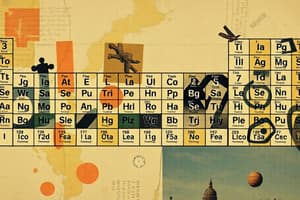Podcast
Questions and Answers
Which state of matter has a definite shape and volume?
Which state of matter has a definite shape and volume?
- Gas
- Plasma
- Liquid
- Solid (correct)
Chemical properties can be observed without changing the substance.
Chemical properties can be observed without changing the substance.
False (B)
What are the three main types of chemical bonds?
What are the three main types of chemical bonds?
Ionic bonds, covalent bonds, and metallic bonds
The smallest unit of an element is called an ______.
The smallest unit of an element is called an ______.
Match the following groups with their descriptions:
Match the following groups with their descriptions:
What defines the atomic number of an element?
What defines the atomic number of an element?
Mixtures can only consist of two elements.
Mixtures can only consist of two elements.
When electrons are shared between atoms, the bond formed is called a ______ bond.
When electrons are shared between atoms, the bond formed is called a ______ bond.
Flashcards are hidden until you start studying
Study Notes
Matter and Its Properties
- Definition of Matter: Anything that has mass and occupies space.
- States of Matter:
- Solid: Definite shape and volume; particles closely packed.
- Liquid: Definite volume but takes the shape of the container; particles close but can move past each other.
- Gas: Neither definite shape nor volume; particles far apart and move freely.
- Properties of Matter:
- Physical Properties: Can be observed without changing the substance (e.g., color, density, boiling point).
- Chemical Properties: Can only be observed during a chemical reaction (e.g., reactivity, flammability).
Periodic Table
- Structure: Organized in rows (periods) and columns (groups) based on increasing atomic number.
- Groups:
- Vertical columns; elements in the same group have similar chemical properties (e.g., Group 1: Alkali metals, Group 17: Halogens).
- Periods:
- Horizontal rows; properties change progressively across a period.
- Key Sections:
- Metals: Good conductors of heat/electricity, malleable, ductile.
- Nonmetals: Poor conductors, brittle, various states at room temperature.
- Metalloids: Exhibit properties of both metals and nonmetals.
Atomic Structure
- Basic Units: Atom is the smallest unit of an element.
- Components of an Atom:
- Protons: Positively charged, located in the nucleus, determine the atomic number.
- Neutrons: Neutral charge, also in the nucleus, contribute to atomic mass.
- Electrons: Negatively charged, orbiting the nucleus in electron shells.
- Atomic Number: Number of protons in an atom; defines the element.
- Mass Number: Total number of protons and neutrons in the nucleus.
Basic Chemistry
- Elements: Pure substances that cannot be broken down; classified on the periodic table.
- Compounds: Substances made up of two or more different elements chemically bonded (e.g., water, H2O).
- Mixtures: Combination of two or more substances that maintain their individual properties (e.g., air, salad).
- Chemical Bonds:
- Ionic Bonds: Formed when electrons are transferred from one atom to another (e.g., NaCl).
- Covalent Bonds: Formed when electrons are shared between atoms (e.g., O2).
- Reactions: Processes in which substances undergo chemical changes, characterized by reactants and products. Types include synthesis, decomposition, and combustion.
Matter and Its Properties
-
Matter is anything that has mass and occupies space.
-
States of Matter:
- Solids have a definite shape and volume, with particles closely packed.
- Liquids have a definite volume but take the shape of their container, with particles close but able to move past each other.
- Gases have neither a definite shape nor volume, with particles far apart and moving freely.
-
Properties of Matter:
- Physical properties can be observed without changing the substance's chemical composition, such as color, density, and boiling point.
- Chemical properties can only be observed during a chemical reaction, such as reactivity and flammability.
Periodic Table
-
The Periodic Table is organized in rows (periods) and columns (groups) based on increasing atomic number.
-
Groups are vertical columns. Elements in the same group have similar chemical properties. For example, Group 1 contains the alkali metals, and Group 17 contains the halogens.
-
Periods are horizontal rows. Properties change progressively across a period.
-
Key Sections:
- Metals are good conductors of heat and electricity, malleable (can be hammered into thin sheets), and ductile (can be drawn into wires).
- Nonmetals are poor conductors, brittle, and exist in various states at room temperature.
- Metalloids exhibit properties of both metals and nonmetals.
Atomic Structure
-
The atom is the smallest unit of an element.
-
Components of an Atom:
- Protons have a positive charge and are located in the nucleus. They determine the atomic number.
- Neutrons have no charge and are also located in the nucleus. They contribute to the atomic mass.
- Electrons have a negative charge and orbit the nucleus in electron shells.
-
Atomic Number is the number of protons in an atom and defines the element.
-
Mass Number is the total number of protons and neutrons in the nucleus.
Basic Chemistry
-
Elements are pure substances that cannot be broken down into simpler components. They are classified and organized on the Periodic Table.
-
Compounds are substances made up of two or more different elements chemically bonded together, such as water (H2O).
-
Mixtures are combinations of two or more substances that maintain their individual properties, such as air or a salad.
-
Chemical Bonds:
- Ionic bonds are formed when electrons are transferred from one atom to another, like in sodium chloride (NaCl).
- Covalent bonds are formed when electrons are shared between atoms, like in oxygen gas (O2).
-
Reactions are processes in which substances undergo chemical changes. They are characterized by reactants (starting materials) and products (resulting substances). Types of reactions include synthesis, decomposition, and combustion.
Studying That Suits You
Use AI to generate personalized quizzes and flashcards to suit your learning preferences.




